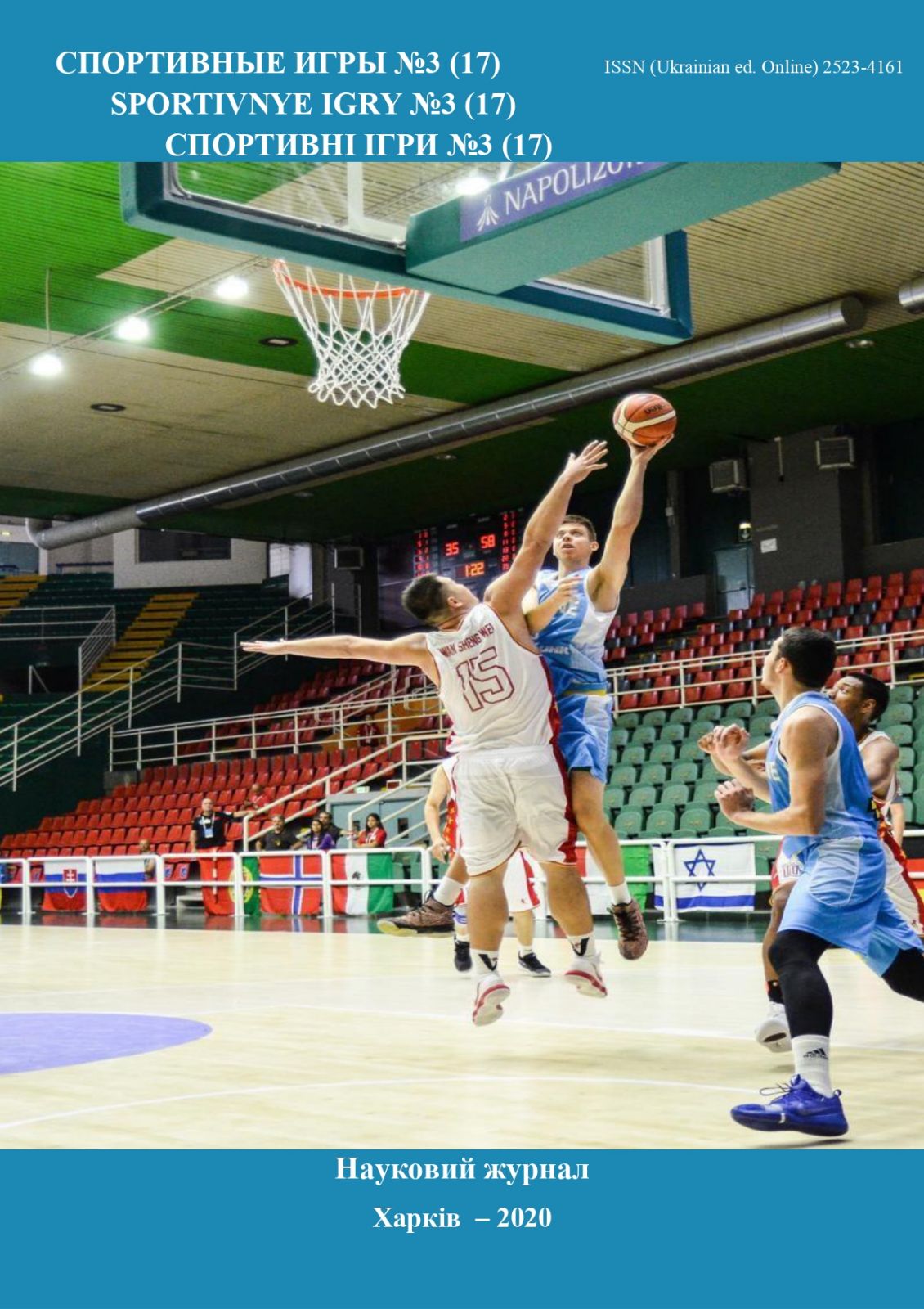Ефективність експериментальної програми швидкісно-силової підготовки футболістів 13-14 років із використанням блоків спеціально підібраних вправ
DOI:
https://doi.org/10.15391/si.2020-3.09Ключові слова:
юні футболісти, підготовка, методика, тестування, швидкість, швидкісно-силові якостіАнотація
Мета – визначити ефективність експериментальної програми швидкісно-силової підготовки футболістів в СДЮШОР «Кристал». Матеріал і методи: у дослідженні прийняли участь дванадцять юних спортсменів віком 13-14 років. Тривалість занять футболом у даних спортсменів знаходилась в межах від 4 до 6 років. Тривалість дослідження жовтень 2018 – квітень 2019 року. Для визначення рівня розвитку швидкісно-силової підготовленості юних футболістів були застосовані наступні тести: біг на 30 м., човниковий біг 3 х 10 метрів, стрибок у довжину з місця, стрибок вгору з місця, вкидання м’яча на дальність, удар по м’ячу на дальність. Сутність методики швидкісно-силової підготовки юних футболістів полягала в тому, що у змісті трьох тренувань на тиждень були передбачені три блоки швидкісно-силових вправ. Використовувався метод колового тренування де тренер розбивав футболістів на три групи. Весь блок виконувався у 6 кіл. Відпочинок між колами 2 хв. Блок розрахований на розвиток м’язів ніг та верхнього плечового поясу, вибухової сили та швидкісної витривалості. Результати: визначивши рівень розвитку швидкісно-силових якостей на початку дослідження та по його завершенню встановлено, що зміни відбулися за всіма проведеними тестами. За показниками загальної швидкісно-силової підготовленості юних футболістів встановлено, що за тестом біг на 30м середнє значення групи змінилося з 4,8 с до 4,6 с (приріст 4,2%); за тестом човниковий біг на 3х30 метрів було 8,31 с, стало 7,86 с (приріст 5,6%); за тестом стрибок у довжину з місця з 192,9 см на 198,5 см (приріст 2.8%); за тестом стрибок угору з місця було 39 см, стало 40,7 см (приріст 4,2%). За показниками спеціальної швидкісно-силової підготовленості теж відбулися позитивні зрушення: за тестом вкидання м’яча на
дальність результати покращилися з 17,5 м до 18,3 м (приріст 4,4%); а за тестом удар по м’ячу на дальність - з 49,9 м до 51,6 м (приріст 3,3%). Висновки: експериментально встановлено, що використана в тренувальному процесі блочна методика швидкісно-силової підготовки футболістів 13-14 років є ефективною. Її застосування дозволило досягти суттєвих зрушень практично по кожному з тестових випробувань. Проте існує перспектива подальших досліджень, яка пов’язана з продовженням використання розробленої методики, для визначення її ефективності за більш тривалий період тренування з незначним коректуванням її змісту за рахунок введення вправ інтегральної спрямованості.
Посилання
Алиев, Э.Г., Андреев, С.Н., & Губа, В.П. (2012). Мини-футбол (футзал). Москва : Советский спорт.
Андреев, С.Н., Левин, В.С. (2004). Мини-футбол. Липецк : Арес.
Губа, В.П. (2016). Теория и методика мини-футбола (футзала). Москва : Спорт.
Гузарь, В.Н., Шалар, О.Г., & Норик, А.О. (2014). Взаимоотношения как аспект психологического климата женской футбольной команды. Физическое воспитание студентов, 2, 8-12. doi: 10.6084/m9/figshare. 906307
Гусев, В.Г., Стрикаленко, Є.А., & Шалар, О.Г. (2014). Аналіз фізичної підготовленості футболістів високого класу. Науковий часопис НПУ ім. М.П. Драгоманова, 6 (49), 35-42.
Жосан Ігор, Стрикаленко Євгеній, & Шалар Олег (2014). Технічне обладнання в тренуванні юних футболістів. Фізична культура, спорт та здоров’я нації: збірник наукових праць. Вінницький державний педагогічний університет імені Михайла Коцюбинського, 17, 448-454.
Жосан, І.А., Хоменко, В.В., & Шалар, О.Г. (2016). Порівняння техніко-тактичних дій крайніх захисників на чемпіонаті світу з футболу 2014 року. Науковий часопис Національного педагогічного університету імені М.П. Драгоманова, 3 (72), 60-63.
Зеленцов, А.М., Лобановський, В.В., Коуэрвер, В., & Ткачук, В.П. (1996). Уроки футбола. Київ : Олімпійська література.
Еделев, О.С., Єфімако, В.О., & Шалар, О.Г. (2008). Дидактико-виховний аспект тренування юних футболісток. Педагогіка, психологія та медико-біологічні проблеми фізичного виховання і спорту, 11, 16-20.
Козловский, В.И. (1999). Подготовка футболистов. Москва : Физическая культура и спорт.
Лисенчук, Г., Догадало, В., & Колотов, В. (1997). Отбор и прогнозирование достижений как инструмент управления соревновательной деятельностью в футболе. Наука в олимпийском спорте, 1, 57-63.
Соломонко, В.В., Лисенчук, Г.А., & Соломонко, О.В. (1997). Футбол. Київ : Олімпійська література.
Стрикаленко Є.А., Шалар О.Г., Гузар В.М. (2020). Ефективність побудови тренувального процесу футззалістів ФК «Продексім» в підготовчому періоді. Спортивні ігри, 1 (15), 44-47. doi: 10.15391/si.2020-2.05.
Шалар, О.Г., Стрикаленко, Є.А., & Ємельянова, Ю.І. (2009). Формування особистості юних футболісток. Педагогіка, психологія та методико-біологічні проблеми фізичного виховання і спорту, 10, 277-280.
Шалар, О.Г., Гузар, В.М., & Хоменко, В.В. (2019). Вплив спортивного тренування на фізичну та технічну підготовленість футболістів. Актуальні проблеми громадського здоров’я та рухова активність різних верств населення, 200-205.
Bolotin, A. & Bakayev, V. (2017). Pedagogical conditions required to improve the speed-strength training of young football players. Journal of Physical Education and Sport, (JPES) 17(2), 95, 638-642.
Hakman, A., Vaskan, I., Kljus, O., Liasota, T., Palichuk, Y., & Yachniuk, M. (2018). Analysis of the acquisition of expertise and mastery of physical skills for performing techniques by young footballers. Journal of Physical Education and Sport, 18, 1237-1242. https://doi.org/10.7752/jpes.2018.s2184.
Gamble, Declan, Spencer, Matt, McCarren, Andrew, & Moyna, Niall. (2019). Activity profile, PlayerLoad™ and heart rate response of Gaelic football players: A pilot study. Journal of Human Sport and Exercise, 14(4), 711-724. doi:10.14198/jhse.2019.144.01.
Kassiano, Witalo, Andrade, Ana Denise, Jesus, Karla de , Lima, Antônio Barroso, Simim, Mário Antônio, Medeiros, Alexandre Igor Araripe, Assumpção, & Cláudio de Oliveira (2019).
Neuromuscular parameters and anaerobic power of U-20 futsal players. Journal of Human Sport and Exercise, 14(1), 207-214. doi:10.14198/jhse.2019.141.17.
Gomez-Piqueras, Pedro, Gonzalez-Villora, Sixto, Castellano, Julen, & Teoldo, Israel (2019).
Relation between the physical demands and success in professional soccer players. Journal of Human Sport and Exercise, 14(1), 1-11. doi:10.14198/jhse.2019.141.01.
Smpokos, Emmanouil, Mourikis, Christos, & Linardakis, Manolis (2018). Seasonal physical performance of a professional team’s football players in a national league and European matches. Journal of Human Sport and Exercise, 13(4), 720-730. doi:10.14198/jhse.2018.134.01
Evangelos, Bekris, Gioldasis, Aristotelis, Ioannis, Gissis, &Georgia, Axeti (2018). Relationship between time and goal scoring of European soccer teams with different league ranking. ournal of Human Sport and Exercise, 13(3), 518-529. doi:10.14198/jhse.2018.133.04.
Abbott, Will, Brickley, Gary , & Smeeton, Nicholas J. (2018). Physical demands of playing position within English Premier League academy soccer. Journal of Human Sport and Exercise, 13(2), 285-295. doi:10.14198/jhse.2018.132.04.
Pratas, José Maria, Volossovitch, Anna, & Carita, Ana Isabel (2018). Goal scoring in elite male football: A systematic review. Journal of Human Sport and Exercise, 13(1), 218-230. doi:10.14198/jhse.2018.131.19.













